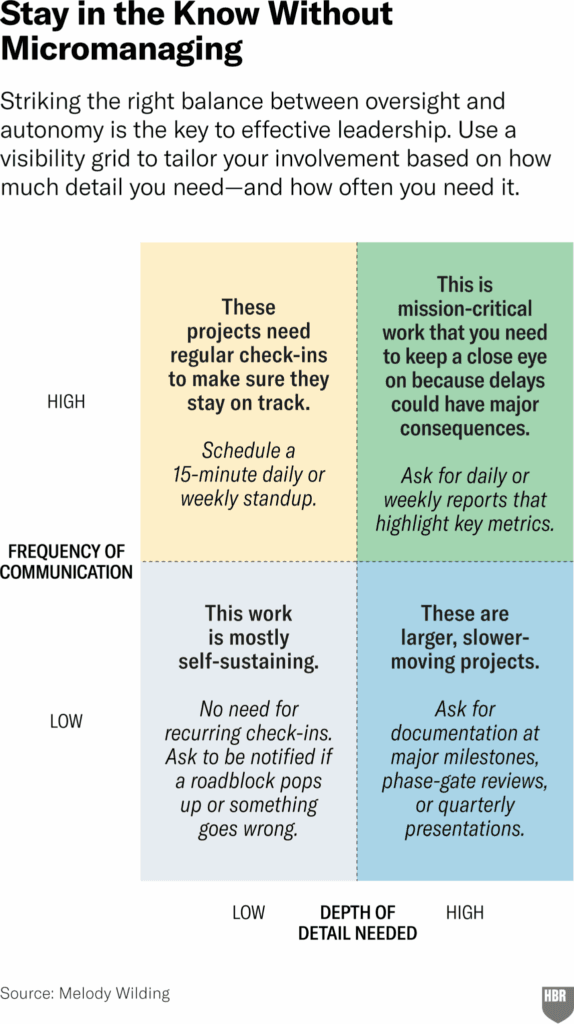Table of Contents
- Why This Article Matters
- The Visibility Grid Explained
- How can I stay informed without micromanaging my team?
- Action Recap
- How do I start building trust while keeping accountability?
Why This Article Matters
Leaders are under constant pressure to know what’s happening inside their teams—what’s on track, what’s behind, and where resources are going. Melody Wilding’s HBR article points out that the real challenge isn’t whether you have information, but how you get it. Too little oversight and you risk being blindsided. Too much, and you fall into micromanagement, undermining trust and motivation.
This is more than a workflow issue—it’s a trust issue. When leaders calibrate their oversight, they show they believe in their teams while still protecting key priorities. The goal isn’t zero involvement. The goal is informed autonomy.
The Visibility Grid Explained
Wilding introduces a simple but powerful tool: a 2×2 matrix that considers how much detail you need and how often you need it. Mission-critical projects may require daily updates and real-time alerts, while routine, self-sustaining work may only need milestone notifications.
When leaders clearly define the kind of visibility they need, they reduce ambiguity for their teams. They also prevent slipping into the trap of trying to monitor everything equally, which often backfires.

When Over-Involvement Becomes the Default
I once coached Ruthie, a team leader who felt trapped between her own director and a COO who was deeply involved in every detail. During one session, she sighed and said:
“She’s been getting in the weeds so much. I don’t feel it’s my place to say anything to the COO, but my director might feel stuck because that’s her boss… I think it’s just adding to the frustration where we’re getting emails about different things, and nothing’s changing.”
I could see how much this weighed on her. Ruthie wanted to respect her leaders, but the constant email churn and top-down instructions drained energy from the work itself. Looking back, using a visibility grid could have given her language to advocate for clearer expectations and less intrusive oversight. It might have prevented the constant “just checking in” cycle and freed the team to focus on what mattered most.
How can I stay informed without micromanaging my team?
Wilding emphasizes two practical steps: (1) set clear expectations for how updates are shared, and (2) adjust oversight based on people’s track records. Here’s how to put that into practice.
1. Define What “In the Loop” Means
Avoid vague language like “just keep me posted.” Be explicit: what kind of update, how often, and in what format?
2. Use a Lighter Touch Where Trust is Strong
If a team member consistently delivers, reduce update frequency and depth. Trust is shown by loosening your grip while still holding accountability.
The Fear of Letting Go
Another client, a first-time manager, came into coaching looking exhausted. She leaned back in her chair and said:
“I want to lead the team, but I don’t think I’ve given them the chance yet. I’m afraid if I let go too much, things will fall apart.”
That fear is common. She cared so much about getting things right that she hadn’t trusted her team to carry work without her constant check-ins. A visibility grid could have helped her see where to loosen her grip and where to stay close. It could have given her confidence to delegate without feeling like she was abandoning her role. Even without it, she eventually built trust step by step—but this tool could have gotten her there faster.
3. Address Gaps Quickly and Transparently
If you need more detail or more frequent check-ins, explain why and connect it to broader goals.
4. Create Safe Space for Feedback About Your Oversight
If people feel they can’t talk about your leadership style, micromanagement issues can fester. Regularly ask, “How is it for you to provide these updates?”
The Emotional Cost of Silence
Ruthie described her workplace as a pressure cooker—not because the work was impossible, but because no one felt safe speaking up:
“The director and I agree, but it’s like no one feels safe to actually address it… so things just keep piling up.”
I heard the frustration behind those words: she and her director both knew the oversight style wasn’t working, but hierarchy made the topic taboo. A tool like the visibility grid could have helped earlier—by making oversight an objective conversation about risk and visibility instead of a personal judgment. Without that safe structure, conversations were delayed until burnout and turnover forced a change.
Action Recap
- Map projects using the visibility grid to clarify which ones require frequent updates and which don’t.
- Communicate your oversight expectations clearly, connecting them to team success.
- Adjust oversight levels based on trust and performance history.
- Invite feedback about your leadership approach so issues don’t linger in silence.
These steps help you move from reactive check-ins to purposeful visibility—maintaining accountability without falling into micromanagement.
Coaching in Action: Using the Visibility Grid the Same Day
Just hours after reading Melody Wilding’s article, I used the Visibility Grid in a session with a client who was concerned about one of her direct reports. She worried that the employee might be treating out-of-office days as travel days—or not working much at all.
Through our conversation, she clarified that the work done on those days is mission-critical and already behind schedule. Using the grid helped her see why closer oversight was justified. She decided to ask for end-of-day reports summarizing who had been contacted and what steps had been taken. Because this change was tied to the importance of the work and current delays, it wasn’t about controlling the employee’s every move but about ensuring critical outcomes. I also shared the HBR article with her as a resource.
How do I start building trust while keeping accountability?
Micromanagement rarely begins with bad intentions. It’s often the byproduct of caring about outcomes and fearing failure. But staying too close for too long erodes trust and engagement. Wilding’s visibility grid gives leaders a way to calibrate involvement while empowering their teams.
If you’re unsure where to start, pick one project and one person. Apply the visibility grid, agree on what updates look like, and notice how the dynamic shifts. This is the work of leadership: not holding all the strings yourself, but empowering people to carry their own weight—while knowing you still see what matters most.
Book a consult if you want to explore how to build trust while keeping oversight strong.
Author Bio
Amy Kay Watson is a Master Certified Coach (MCC) and a champion for empathy and compassion in performance improvement. She helps leaders manage accountability with clarity and kindness across sectors from tech to government. Learn more about Amy.
FAQ
Q: What if my team resists providing updates?
A: Clarify why updates matter, connect them to shared success, and adjust the format to be less burdensome.
Q: How do I know if I’m micromanaging?
A: If team members act as if your updates feel redundant, or you’re getting feedback that you have been correcting work that isn’t broken, it’s time to recalibrate.
Q: How do I build trust while still getting visibility?
A: Discuss and use agreed-upon rhythms and formats, then step back unless there’s a clear need to step in.

